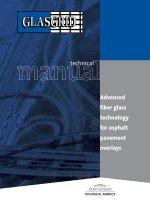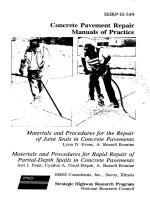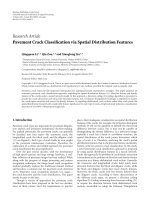Pavement Design-converted
Bạn đang xem bản rút gọn của tài liệu. Xem và tải ngay bản đầy đủ của tài liệu tại đây (1.45 MB, 43 trang )
CEE 320
Winter 2006
Pavement Design
CEE 320
Steve Muench
Outline
1.
2.
3.
4.
Pavement Purpose
Pavement Significance
Pavement Condition
Pavement Types
a. Flexible
b. Rigid
CEE 320
Winter 2006
5. Pavement Design
6. Example
Pavement Purpose
CEE 320
Winter 2006
• Load support
• Smoothness
• Drainage
DC to Richmond Road in 1919 – from the Asphalt Institute
Pavement Significance
• How much pavement?
–
–
–
–
3.97 million centerline miles in U.S.
2.5 million miles (63%) are paved
8.30 million lane-miles total
Largest single use of HMA and PCC
• Costs
CEE 320
Winter 2006
– $20 to $30 billion spent annually on pavements
– Over $100 million spent annually in WA
CEE 320
Winter 2006
Pavement Condition
CEE 320
Winter 2006
Pavement Condition
CEE 320
Winter 2006
Pavement Condition
From WSDOT
I – 90 “fat driver” syndrome
CEE 320
Winter 2006
Pavement Condition
Pavement Condition
• Defined by users (drivers)
• Develop methods to relate physical
attributes to driver ratings
• Result is usually a numerical scale
CEE 320
Winter 2006
From the AASHO Road Test
(1956 – 1961)
CEE 320
Winter 2006
Present Serviceability Rating (PSR)
Picture from: Highway Research Board Special Report 61A-G
FYI – NOT TESTABLE
Present Serviceability Index (PSI)
• Values from 0 through 5
• Calculated value to match PSR
(
)
PSI = 5.41 − 1.80 log 1 + SV − 0.9 C + P
SV = mean of the slope variance in the two wheelpaths
(measured with the CHLOE profilometer or BPR Roughometer)
C, P = measures of cracking and patching in the pavement surface
CEE 320
Winter 2006
C = total linear feet of Class 3 and Class 4 cracks per 1000 ft2 of pavement area.
A Class 3 crack is defined as opened or spalled (at the surface) to a width of
0.25 in. or more over a distance equal to at least one-half the crack length.
A Class 4 is defined as any crack which has been sealed.
P = expressed in terms of ft2 per 1000 ft2 of pavement surfacing.
CEE 320
Winter 2006
Serviceability (PSI)
Typical PSI vs. Time
p0
p0 - pt
pt
Time
Design Parameters
CEE 320
Winter 2006
• Subgrade
• Loads
• Environment
Subgrade
• Characterized by strength
and/or stiffness
– California Bearing Ratio (CBR)
• Measures shearing resistance
• Units: percent
• Typical values: 0 to 20
– Resilient Modulus (MR)
CEE 320
Winter 2006
• Measures stress-strain relationship
• Units: psi or MPa
• Typical values: 3,000 to 40,000 psi
Picture from University of Tokyo Geotechnical Engineering Lab
Subgrade
Some Typical Values
Classification
Good
Fair
CEE 320
Winter 2006
Poor
CBR
≥ 10
5–9
3–5
MR (psi)
Typical Description
20,000
Gravels, crushed stone and sandy
soils. GW, GP, GM, SW, SP, SM
soils are often in this category.
10,000
Clayey gravel and clayey sand, fine
silt soils. GM, GC, SM, SC soils are
often in this category.
5,000
Fine silty sands, clays, silts, organic
soils. CL, CH, ML, MH, CM, OL, OH
soils are often in this category.
Loads
• Load characterization
CEE 320
Winter 2006
–
–
–
–
–
Tire loads
Axle and tire configurations
Load repetition
Traffic distribution
Vehicle speed
Load Quantification
• Equivalent Single Axle Load (ESAL)
– Converts wheel loads of various magnitudes and repetitions
("mixed traffic") to an equivalent number of "standard" or
"equivalent" loads
– Based on the amount of damage they do to the pavement
– Commonly used standard load is the 18,000 lb. equivalent
single axle load
• Load Equivalency
– Generalized fourth power approximation
CEE 320
Winter 2006
4
load
= relative damage factor
18,000 lb.
Typical LEFs
6
ESALs per Vehicle
5.11
5
4
3
1.85
2
1.35
1
0.0007
0.10
Car
Delivery Truck
0
Loaded 18-Wheeler
Loaded 40' Bus
Loaded 60'
Articulated Bus
CEE 320
Winter 2006
Notice that cars are insignificant and thus usually
ignored in pavement design.
LEF Example
The standard axle weights for a standing-room-only loaded Metro
articulated bus (60 ft. Flyer) are:
Axle
Steering
Middle
Rear
Empty
13,000 lb.
15,000 lb.
9,000 lb.
Full
17,000 lb.
20,000 lb.
14,000 lb.
CEE 320
Winter 2006
Using the 4th power approximation, determine the total equivalent
damage caused by this bus in terms of ESALs when it is empty. How
about when it is full?
Environment
• Temperature extremes
• Frost action
CEE 320
Winter 2006
– Frost heave
– Thaw weakening
Pavement Types
• Flexible Pavement
– Hot mix asphalt (HMA) pavements
– Called "flexible" since the total pavement structure
bends (or flexes) to accommodate traffic loads
– About 82.2% of paved U.S. roads use flexible pavement
– About 95.7% of paved U.S. roads are surfaced with HMA
• Rigid Pavement
CEE 320
Winter 2006
– Portland cement concrete (PCC) pavements
– Called “rigid” since PCC’s high modulus of elasticity
does not allow them to flex appreciably
– About 6.5% of paved U.S. roads use rigid pavement
Flexible Pavement
• Structure
CEE 320
Winter 2006
–
–
–
–
Surface course
Base course
Subbase course
Subgrade
Types of Flexible Pavement
CEE 320
Winter 2006
Dense-graded
Open-graded
Gap-graded
FYI – NOT TESTABLE
CEE 320
Winter 2006
Flexible Pavement – Construction
Rigid Pavement
• Structure
CEE 320
Winter 2006
–
–
–
–
Surface course
Base course
Subbase course
Subgrade









